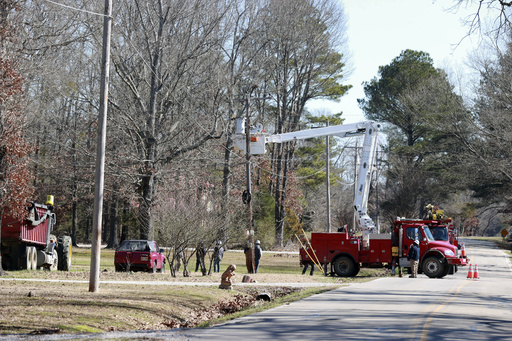BISMARCK, N.D. — A frigid wave of Arctic air moved into the central United States on Monday, bringing with it bone-chilling temperatures as a polar vortex affected regions from the Rockies to the Northern Plains. This blast of cold followed the severe weekend storms that resulted in widespread flooding across the Eastern U.S., leading to the loss of at least 14 lives.
The National Weather Service issued warnings about “life-threatening cold” conditions, with wind chills plummeting to minus 60 degrees Fahrenheit (minus 51 degrees Celsius) in various areas of North Dakota and minus 50 F (minus 46 C) in parts of Montana. Forecasters indicated that temperatures may drop even further by Tuesday morning.
Extreme weather alerts were issued for 11 states, extending from the Canadian border down to Oklahoma and central Texas. As the Arctic front advances, residents can expect near-record breaking temperatures and dangerously low wind chills in the single digits by midweek.
Meteorologists noted that this season marks the 10th event of a polar vortex, with meteorological influences from the Arctic pushing icy air that typically remains near the North Pole into both the U.S. and Europe.
In Kentucky, recent floodwaters have led to an increase in reported deaths, with Governor Andy Beshear confirming that the death toll has risen to 12. The state encountered serious weather events resulting in two deadly vehicle accidents attributed to the severe conditions. Over 1,000 individuals needed rescue after being trapped by floods.
Heavy rainfall, reaching up to six inches (15 centimeters), hit parts of Kentucky and Tennessee, while submerged vehicles and buildings across Kentucky added to the devastation. Meanwhile, mudslides obstructed roads in Virginia.
In West Virginia, one death has been confirmed, and several individuals remain unaccounted for as Governor Patrick Morrisey petitioned for a disaster declaration for a flood-affected 13-county area. Near Logan, officials dealt with an incident involving an acidic water spill from an abandoned coal mine, which caused road damage that rendered it impassable.
Additionally, in Atlanta, strong winds and rain resulted in a fatality when a large tree fell on a house early Sunday morning. Flood warnings were subsequently extended across a wide region, including Kentucky and parts of Arkansas, Tennessee, Virginia, Ohio, Mississippi, Alabama, and West Virginia.
The Midwest and Northeast also faced snowstorms. A state trooper tragically lost their life while responding to an accident on Interstate 80 in Nebraska, where many areas had been placed under winter weather advisories.
Hazardous travel conditions persisted across Michigan, which remained under a winter weather advisory until Monday afternoon. Similarly, Colorado reported at least eight fatalities from vehicle crashes linked to the weather since Valentine’s Day, prompting authorities to advise caution to drivers. Avalanche warnings were issued for sections of the Rocky Mountains, particularly in Colorado, Utah, Idaho, and Wyoming, where the avalanche risk was deemed high.
An avalanche warning was also declared for parts of New Hampshire’s White Mountains, following an incident where two ice climbers triggered an avalanche, partially burying one of them. Fortunately, they were rescued safely.
In Detroit, a significant water main break inundated parts of a neighborhood, leading to flooding of streets, sidewalks, and yards. Firefighters responded, using ladders to assist individuals trapped in waist-deep water and bulldozers to help residents evacuate. The 54-inch (137-centimeter) transmission main, dating back to 1930, suffered a failure, and workers were still trying to determine the cause.
Residents in the flood-affected areas were advised by Mayor Mike Duggan to shelter in their homes if they have power and feel secure; those wanting to evacuate could call 911 for assistance to temporary shelters.
As this cold snap grips the country, it has been noted that January often records the lowest temperatures of the year. Meteorologist Jason Anglin emphasized the importance of protecting exposed skin from frostbite in such frigid conditions and encouraged neighbors to check on vulnerable individuals.
To address the severe cold and limited heating fuel resources, North Dakota’s Governor Kelly Armstrong waived hours-of-service limitations for commercial drivers transporting propane and petroleum products, effective for 30 days. This cold weather is expected to decrease oil production in the state by about 5%, equivalent to 50,000 to 80,000 barrels daily, a pattern consistent during such climatic events.
Animal welfare organizations are reporting increased risks for animals in these extreme temperatures, with fatalities occurring quickly, as stated by Julie Schirado, founder of the Furry Friends Rockin’ Rescue shelter in Bismarck. She urged pet owners to bring their animals indoors during these harsh conditions for their safety.
At the Dakota Zoo, animals like bison and elk are faring well despite the cold, with staff taking necessary precautions to ensure they have adequate food and water. Zoo Director Terry Lincoln humorously recounted that even a short walk in these temperatures could feel as shocking as an ice cream headache.
